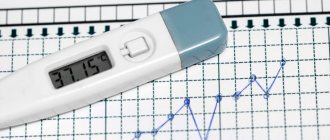The most common question a gynecologist asks during an examination is “do you have a regular menstrual cycle?” For a woman, the systematic and regular onset of menstruation is the main sign that everything is in order with her body. Any disturbances associated with its duration, intensity and the presence of pathological pain causes concern and the need to seek help.
An increase in temperature before menstruation is also a deviation from the norm, because in the second phase of the cycle after ovulation, basal temperature (BT), on the contrary, should decrease slightly, but its increase in combination with severe pain and nausea is a clear sign of illness, an inflammatory process, or the onset of pregnancy.
The temperature before menstruation rises slightly, no higher than 37-37.1 degrees, so a woman may not even feel it. There are 2 types of reasons for which the value on the thermometer may rise:
- Physiology.
- Pathology.
Reasons of a physiological nature
A few days before the onset of menstruation, your body temperature may change and this is normal. Some representatives of the fair sex may have a feeling of an oncoming cold: chills, unreasonable lethargy, sweating.
In fact, this means that temporary hormonal changes occur in the body. The reasons why a high temperature before menstruation may be due to the following conditions:
- perhaps the body is preparing for the onset of menstruation;
- pregnancy has occurred;
- A woman has premenstrual syndrome.
Normal onset of menstruation
Typically, an increase in the value on the thermometer to 37 before menstruation is a common individual reaction of the body to hormonal changes in connection with the approaching menstruation. Female sex hormones in different concentrations can affect thermoregulation:
- progesterone before menstruation can raise the temperature;
- Due to increased estrogen levels, the temperature drops.
In the second phase of the cycle, the concentration of progesterone usually increases, which means that a body temperature of 37 is normal. It is also not a pathology if the temperature rises for the following reasons:
- a woman may have a natural increase in the production of progesterone in the post-ovulation period;
- during menstruation, blood actively flows to the pelvic organs;
- for women with hypersensitivity, the norm is if the low-grade fever before menstruation rises slightly within 3-4 days.
Onset of pregnancy
If a woman does not know why the temperature rises before menstruation, then the simplest explanation is pregnancy. If, in addition to low-grade fever (stable body temperature within 37-38 degrees), the basal temperature in the rectum is also elevated, and menstruation has not yet begun, then with a high degree of probability we can say that the egg is fertilized.
For this reason, women who want to become pregnant are advised to monitor their basal body temperature; it more accurately predicts conception. Basal temperature can be measured not only in the anus, but also in the mouth and vagina. But be careful, because it can be affected by the following factors:
- drinking alcohol;
- taking sedatives;
- hormonal therapy.
If the body temperature is elevated before menstruation, and the day before it drops to the base temperature, then the egg is not fertilized and the hormonal background has changed again.
For women trying to get pregnant, it is very important to know what the temperature should be in a particular phase of the cycle in order to understand whether fertilization can occur on that day or whether it is better to wait for more favorable conditions.
Another tip for those who want to become mothers: to increase your chances of conceiving, you need to wait until your basal temperature rises in the morning; such a rise indicates the onset of ovulation.
It is not at all necessary that a modern woman’s temperature rise to 37.0 degrees. The most important thing is to track ovulation.
PMS
Premenstrual syndrome is a sign of hormonal changes that occur throughout the menstrual cycle. Signs of PMS:
- weakness and lethargy;
- causeless aggression;
- bloating;
- chest pain;
- poly in the lower back and back;
- headache;
- The body temperature may increase slightly.
Features of the course of premenstrual syndrome:
- begins at the age of 25-30 and only progresses in the future;
- depends on the concentration of progesterone and estrogen;
- worsens in women with thyroid diseases;
- may be exacerbated by a lack of zinc, magnesium, calcium and vitamin B6.
Usually, an increase in body temperature before menstruation due to PMS does not require additional treatment, even if its value reaches 39 degrees, after a while it will return to normal. If other symptoms occur, you need to consult a gynecologist and endocrinologist to alleviate the condition.
Dietary nutrition, giving up bad habits, regular exercise and an active sex life will help you cope with PMS. Also avoid stress and normalize your daily routine.
Why does the temperature rise slightly before menstruation?
Many women complain of discomfort that occurs a few days before the onset of menstruation, such as headaches, breast swelling, abdominal or lower back pain, nausea, etc.
This also applies to increased temperature, which does not occur as often as the listed phenomena, but causes inconvenience. Why does this happen? Can the temperature rise before the next period? Is this condition normal? How to distinguish normality from pathology?
Surely all women know that certain sex hormones, constantly produced by the body, are responsible for the course of cycles. An increase in basal temperature to 37°C or higher is due to high levels of the hormone progesterone in the blood.
This is due to the fact that progesterone can affect the temperature regulation center, which is located in the brain. It is its impact that leads to the fact that, at first glance, the temperature increases for no reason. Such a slight increase can be noticed either by ladies with very high sensitivity, or by those who regularly measure rectal (basal) body temperature. The latter, as a rule, is practiced when monitoring the ovulation process, which, in turn, is necessary when planning pregnancy for the successful conception of a child.
Plotting a basal temperature chart allows you to determine the time of ovulation and, accordingly, the most favorable days for conception. The thermometer reading always rises above normal before the release of an egg ready for fertilization from the ovarian follicle.
The process that causes an increase in temperature begins in about a week, then the temperature before menstruation is approximately 37°C, and when the latter begins, due to a decrease in progesterone production, the levels drop again, reaching the usual 36.6°C.
However, such fluctuations are not observed among all representatives of the fair sex. This is not a pathology or a deviation from the norm in either case. But if other unpleasant sensations appear, you need to consult a doctor and undergo an examination.
Pathological causes
If the temperature is 37 before menstruation, this is not a pathology, but if the mark on the thermometer rises to 38 or higher, you should immediately consult a doctor and find out the reasons for this behavior of your body.
The temperature may rise if you have the following diseases:
- appendages are inflamed (adnexitis). The main sign of the presence of inflammation is a temperature value of 37.5-37.7 degrees, there is also aching pain in the lower abdomen, nausea, vomiting, excessive sweating and problems with urination. If you also have periods with a temperature in the rectum that is higher than normal, then there is no doubt that the woman has a gynecological disease;
- the uterus is inflamed (endometritis). After and before menstruation, the value on the thermometer increases to 37 and persists for a long period. In some cases, diarrhea was noted, as well as aching pain in the lower abdomen, an increased concentration of ESR and the level of leukocytes in the blood;
- infection in the vagina. Menstruation is a period that increases the risk of infection not only in the vagina, but also in the uterus;
- inflammatory processes in the intestines. The temperature jumps to 38, diarrhea begins, the skin and mucous membranes dry out;
- ectopic pregnancy or spontaneous abortion during a normal pregnancy. In such cases, the value on the thermometer jumps to 39. To confirm the presence of pregnancy, you need to do a test or get tested for hCG;
- luteal phase deficiency. If the basal temperature before menstruation is high and does not fall, this may mean that progesterone production is low, with the second phase of the cycle lasting up to 10 days or less. This condition is very often the cause of infertility.
Increased temperature before menstruation and its delay
In this case, consider the increase in basal temperature and the absence of menstruation at the prescribed time. In such a situation, when temperatures reach 37°C, there is a high probability of successful fertilization of the egg, that is, this phenomenon indicates the onset of pregnancy. The indicators rise as usual, as before menstruation, but the physiology of this process is completely different, although it is also caused by hormones.
To confirm or deny the presence of pregnancy, it is enough to purchase a special pregnancy test at the pharmacy, based on determining the level of human chorionic gonadotropin in the urine. This substance begins to be actively produced after the embryo attaches to the wall of the uterus, and every day its amount in the body increases significantly.
It is worth noting that only rectal temperature is measured both before and after menstruation. This is the only way to notice minor changes.
Conventional measurements, when the thermometer is placed in the armpit area, will not give correct results. The latter can only be used during colds. Everything related to reproductive function (menstruation, ovulation, pregnancy) is measured only by inserting a thermometer into the anus.
The indicators rise when ovulation occurs, and decrease just before menstruation. This process indicates the absence of fertilization and the imminent onset of bleeding. If pregnancy has occurred, the temperature will remain at 37°C for a long time, and bleeding will not occur.
Fever before menstruation, accompanied by other symptoms
Minor fluctuations that slightly exceed 37°C are not a pathology and are caused by natural processes of the body. Treatment in this case is not required.
If a woman notices brighter fluctuations, which are observed not only before monthly bleeding, but also on other days of the cycle, then we can assume the presence of an inflammatory process that is localized in the genital area. When such a clinical picture appears, medical intervention is required, and as soon as possible.
Types of pathologies that can accompany elevated temperature:
- Inflammation of the appendages. If the basal level before menstruation exceeds the norm, then most likely an inflammatory disease is occurring. However, this process is usually accompanied by other symptoms - nausea, which can lead to vomiting, chills, general weakness, sharp aching pain in the abdominal area, discomfort when urinating;
- Endometritis is inflammation of the inner layer of the uterus. Symptoms, in addition to fluctuations in the thermometer reading, may include increased heart rate, as well as dull abdominal pain. Sometimes there is diarrhea and discomfort when visiting the toilet;
- PMS – premenstrual syndrome. Very often at this time the nipples are cut, irritability occurs, but unlike the above pathologies, the thermometer mark does not exceed the permissible limits.
Why does the temperature rise during menstruation?
Changes in indicators can be observed directly on these days. Specialists in the field of gynecology agree that minor fluctuations are not a deviation from the norm.
- This is due to the fact that critical days are a kind of stress for the body, as they are accompanied by severe blood loss and dehydration. This is why some particularly sensitive women may experience weakness and apathy, and the thermometer rises due to simple fatigue.
But strong fluctuations, especially those accompanied by pain, are a pathology. In such a situation, it is necessary to contact an antenatal clinic and undergo diagnostic procedures to find out the cause of the pain. The fact is that the normal concentration of sex hormones in the blood does not cause discomfort during menstrual periods. And if discomfort occurs, it means that there are disturbances in the body. During monthly bleeding, the thermometer mark may rise due to inflammatory diseases of the uterus.
- Before the start of the critical days, the neck of the organ (cervical canal) expands slightly, and accordingly, pathogenic microorganisms easily penetrate into the organ. This often leads to inflammation of the endometrium. To avoid this, it is necessary to adhere to preventive measures, for example, using sanitary pads rather than tampons. In addition, you must strictly observe intimate hygiene.
- An increase in readings during or before menstruation is in some cases a symptom of infectious diseases of the gastrointestinal tract. This is due to the fact that menstrual periods often provoke diarrhea. Although this disease is not directly related to the reproductive system, it is advisable to undergo diagnostics.
How to alleviate the condition?
An elevated temperature before menstruation is not always a pathology, but if you feel unwell and lethargic, you can alleviate the condition using the following methods:
- make more movements. Physical activity reduces fatigue and improves mood;
- you can take a shower. A shower at room temperature will help relieve fatigue and weakness; water temperatures that are too low or too hot are not suitable. The best option for summer is an outdoor shower;
- make the right diet. Before the onset of menstruation, you need to increase the presence of plant foods in the menu, include more vegetables and fruits. Even if you have not yet figured out why the temperature rises, a diet always brings relief to the body. You also need to give up alcohol;
- maintain a sleep and rest schedule. No matter how busy your everyday life is, find some time for yourself. Relax, get some sleep. Before menstruation, you do not need to visit the bathhouse or engage in strenuous sports;
- reduce the amount of coffee you drink, because this invigorating drink has an effect on hormonal levels.
BT and female body temperature are important indicators that should be monitored to see whether the temperature increases or decreases.
Such information will most reliably establish the presence of infection in the body or will please the woman with the onset of pregnancy.











